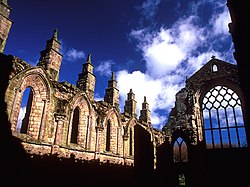Holyrood Abbey

Holyrood Abbey is a ruined Augustinian Abbey in Edinburgh, Scotland. The abbey (which is sited in the grounds of the Palace of Holyroodhouse, which it predates) was built in 1128 at the order of King David I of Scotland. "Rood" is an old word for "cross," usually meaning that of Jesus, so the name is equivalent to "Holy Cross." A legend relates that David got into difficulties hunting in the woods and was saved by a stag with an illuminated cross between its horns, then vowed to build a church on the spot. The name is pronounced "Holly-rood".
Since the fifteenth century, it has been the site of many royal coronations and marriage ceremonies. King James VII ordered the Abbey to be converted to become a chapel for the Order of the Thistle, however the newly-converted building was subsequently wrecked by a mob. The roof of the abbey collapsed in the 18th century, leaving it as it currently stands, a ruin. In 1691 the then-new Kirk of the Canongate replaced the Abbey as the local parish church.
Holyrood Abbey Church (Dalziel Place, Edinburgh)
There is still a Church of Scotland congregation named Holyrood Abbey, however this congregation uses a late-Victorian church building at Dalziel (pronounced dee-ell - see yogh) Place at the junction of Marionville Road and London Road, some distance from the old Holyrood Abbey. The church building was opened in December 1900 as Abbeyhill United Free Church.
Following the Disruption of 1843 in the Church of Scotland, part of the congregation of the Kirk of the Canongate left to form Holyrood Free Church. A new building was constructed in front of the Palace of Holyroodhouse. This congregation united with Abbeyhill United Free Church in 1915, henceforth using the Dalziel Place church buildings. The United Free Church of Scotland united with the Church of Scotland in 1929, the congregation henceforth being known as Holyrood Abbey Church. External link
Today, the Holyrood Abbey Church of Scotland congregation is well-known in Edinburgh for its Conservative Evangelical theology and tradition of expository preaching, developed by the Reverend James Philip MA (the congregation's former minister 1958-1997). Mr Philip was a friend of the Rev William Still, minister at Gilcomston South Church in Aberdeen from 1945 until 1997, the pioneer of expository preaching in the Church of Scotland. The current minister is the Rev Philip Hair BD.
The former Holyrood United Free Church building adjacent to the Palace was used for many years as a storeroom, but in 2003 was extensively renovated and reopened as the "Queen's Gallery" for art exhibitions from the Royal Collections.
The Legend of the Founding of the Abbey
In 1127, while King David I was hunting in the forests near Edinburgh, the King suddenly found himself in the danger of a hart's antlers. Two brothers, Johannes and Gregan from the Barony of Crawford in the Upper Strathclyde (Crawford Castle}, eliminated the danger. The grateful King knighted the brothers and founded Holyrood Abbey the following year. From that day foreward, that branch of the Crawford family adopted the crest of a buck's head erased with a cross of gold between the antlers to commemorate the founding of the Abbey. This family also adopted the motto "Tutum Te Robore Reddam" for "Our strength will give you safety." This crest was adopted by Clan Crawford after 1700 when this branch of the family ascended to the Chiefship through marriage into the existing Chief's lineage.
References
1. Crawfurd, George, "History of the Shire of Renfrew," Alexander Weir Publisher, Paisley, Scotland, 1782.
2. Crawfurd, George, "Peerage of Scotland, Account of Nobility," George Stewart Publisher, Glasgow, Scotland, 1716.
